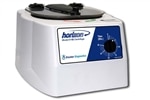Centrifuges are used for the separation of fluids, gas or liquid, based on density and are indispensable lab equipment for any laboratory. There are a wide variety of commercially available centrifuges in the market including blood bank, ultra-units, high-speed models, floor-standing, bench top, and micro-centrifuges. A wide choice of accessories is also available for each model. To choose the right system for particular applications, lab professionals must have a clear idea regarding the specifications of the model they are looking for.
Consider the following aspects when choosing a centrifuge for your laboratory.
- Space availability in your lab - If you are looking for a floor model centrifuge, make sure there's enough space in your lab to accommodate this unit. In a space-constrained lab, it is better to go for a bench top model with the required speed and power that will not take up too much space.
- Maximum speed required - Speed of the system can be determined in terms of Relative Centrifugal Force (RCF) or revolutions per minute (RPM). High-speed as well as low-speed models are available. These units contain motors to produce force, rotors mounted on the motor shaft, and/or inserts and buckets where tubes are positioned. High-speed rotors can help reduce spin times considerably and increase the number of applications that can be completed.
- Capability to handle several different protocols - For laboratories with multiple users, requirements may vary. Different levels of experience require a flexible unit with configurations and technologies to ensure safety, such as automatic rotor identification features. Consider choosing "multi-application" centrifuges as they are equipped with several functions in a single system. They can operate at different speeds and have several rotors to handle several different protocols.
- User-friendliness - Ease of use is a major factor. Consider choosing systems that come equipped with touch screens, enabling users to control parameters through an easy-to-use interface. The user-friendly software enables creating different user levels with improved software controls and varying levels of permissions. Also, choose trouble-free rotor exchange systems that enable removal of the rotor in just seconds, allowing for easy access and cleaning convenience.
- Safety features - Check whether the chosen model includes important safety features such as a lid lock, clear lid for observation of samples, Cool-Flow air flow design and automatic rotor imbalance detection.
Choosing the suitable accessories is also crucial, as they can increase the capabilities of a centrifugal system. Various rotors are available for different tubes and sample containers at various volumes and engineered for safety, comfort and performance. Swing-out rotors with different inserts allow for the spinning of buckets consisting of sample tubes of many capacities at varying speeds. Professional lab equipment suppliers provide a complete line of centrifuges and accessories as well as a comprehensive range of laboratory equipment to address any specific requirement.



